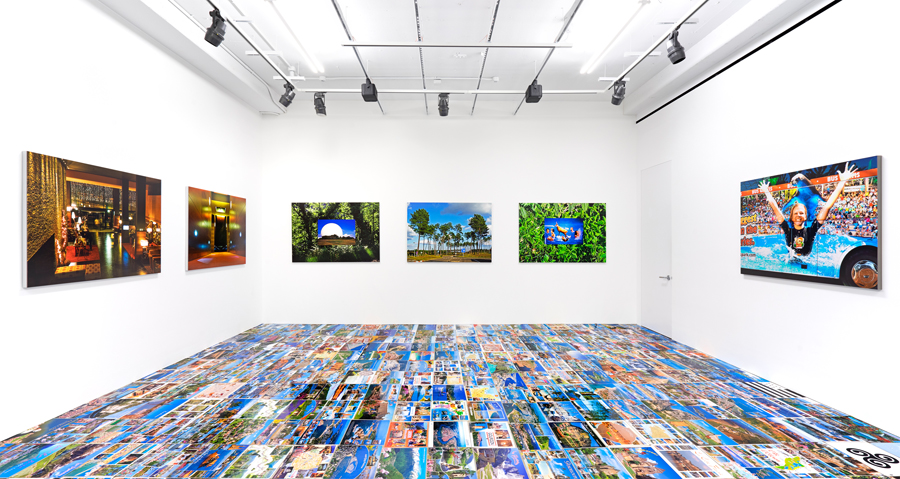Michel Houellebecq
Venus Over Manhattan, New York, USA
Venus Over Manhattan, New York, USA

‘French Bashing’, Michel Houellebecq’s exhibition at Venus Over Manhattan – his first in the US and a follow-up to his 2016 solo show at Palais de Tokyo, Paris – is not the writer’s first engagement with the visual arts. Houellebecq has been taking photos for years, and he also wrote a novel, La Carte et le territoire (The Map and the Territory, 2010), in which the main character is an artist. In the book, Jed Martin shifts from photography to painting portraits of contemporary workers (like customer service providers and journalists, as well as Houellebecq, who pens a catalogue essay, sadly not included in the book, for the fictional artist) that fetch millions of euros in the art market.

Unsurprising to anyone who has read Houellebecq’s novels, the photographs on view in ‘French Bashing’ depict a forbidding, dim world. The author designed the exhibition himself: you walk into a dark room, where greyscale photographs of suburban and rural France are mounted on aluminium and spotlit directly. Where the display is dramatic, the photos are straightforward and banal. France #033, 035, 036 and 037 (all 2016) are hung to connect one non-linear strip of unvarying suburban sprawl, each image imprinted with ‘Avallon suburbs 1’, 2, 3 and 4. In Inscriptions #013 (2017), a dusk sky is inscribed with the sentence ‘time to place your bets’, and in France #002 (2017), the red and blue diamond-shaped logo of the budget supermarket chain Leader Price is saturated using Photoshop to emphasize the grey, grim shop on the outskirts of a small town enveloped by green hills.

The takeaway is facile: civilization is a series of train tracks and big-box stores, toll booths and cement infrastructures. Houellebecq has said in interviews that he does not write landscapes into his novels, for landscapes belong to the realm of photography and people are the concern of literature. Indeed, the photographs are all devoid of human figures, their subjects veritable ghost towns. France #014 (2016) shows another grocery store car park: it’s an image of a public artwork, a concrete sculpture spelling out ‘EUROPE’ next to a huge, rural Carrefour. Houellebecq describes France, but the idea is that France can stand in for other bankrupt or abandoned places.

And then you draw a curtain and move into the adjacent room, brightly lit, its floors covered with laminated placemats with sunny views of French tourist destinations. The ironic shift in lighting enhances the naivety of the images on the ground. This form of ‘French bashing’ critiques the way France sells itself (a leitmotif in The Map and the Territory, where Martin dates a Michelin executive and together they travel the country’s hôtels de charme, now adapted to the tastes of Chinese tourists). But the placemat images don’t elicit contempt from me: instead, I think of people’s dreams and reminiscences, to one day visit the Brittany of postcards, to ski at Praz de Lys, or to remember a trip taken years ago to Île d’Oléron. It may seem sad to dine atop these fantasies, but – at the risk of sounding sentimental – these dreams are nothing to walk all over.

Even if you subscribe to Houellebecq’s grim view of the world, the relationship between his literary work and his photographs is a system of empty repetition: language and image echo each other, neither contributing what the other lacks. The bleak photos in this show are simply illustrations of the France experienced by Houellebecq’s characters. At the end of The Map and the Territory, we discover that Jed Martin spent his last, lonely decades taking photographs again. As he tells a journalist: ‘I simply wanted to give an account of the world.’ In the novel, as in his work, Houellebecq presents art as inert and bereft of potential for change – the simple, unmodified account of a cynical bystander.
Michel Houellebecq, ‘French Bashing’ runs 2 June – 4 August, 2017, at Venus Over Manhattan, New York.
Main image: Michel Houellebecq, Mission #001, 2016, pigment print on Baryta paper mounted on aluminum, 60 x 88 cm. Courtesy: Venus Over Manhattan, New York / Los Angeles

























